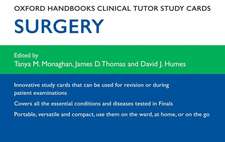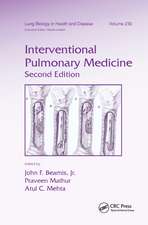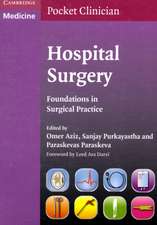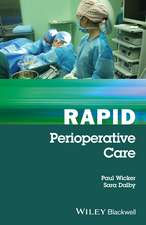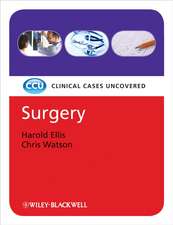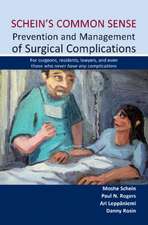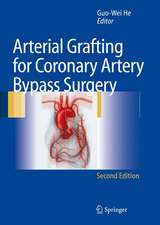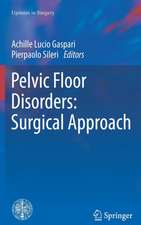Fecal Incontinence and Constipation in Children: Case Studies: Pediatric Colorectal Surgery
Editat de Onnalisa Nash, Julie Choueiki, Marc Levitten Limba Engleză Paperback – 23 sep 2019
Preț: 249.24 lei
Preț vechi: 312.65 lei
-20% Nou
Puncte Express: 374
Preț estimativ în valută:
47.70€ • 51.79$ • 40.07£
47.70€ • 51.79$ • 40.07£
Carte tipărită la comandă
Livrare economică 22 aprilie-06 mai
Preluare comenzi: 021 569.72.76
Specificații
ISBN-13: 9780367151614
ISBN-10: 0367151618
Pagini: 208
Ilustrații: 52 Line drawings, black and white; 16 Tables, black and white; 16 Illustrations, color; 171 Illustrations, black and white
Dimensiuni: 189 x 246 x 19 mm
Greutate: 0.57 kg
Ediția:1
Editura: CRC Press
Colecția CRC Press
Seria Pediatric Colorectal Surgery
Locul publicării:Boca Raton, United States
ISBN-10: 0367151618
Pagini: 208
Ilustrații: 52 Line drawings, black and white; 16 Tables, black and white; 16 Illustrations, color; 171 Illustrations, black and white
Dimensiuni: 189 x 246 x 19 mm
Greutate: 0.57 kg
Ediția:1
Editura: CRC Press
Colecția CRC Press
Seria Pediatric Colorectal Surgery
Locul publicării:Boca Raton, United States
Public țintă
Professional and Professional Practice & DevelopmentCuprins
PART I: BOWEL MANAGEMENT. General guidelines for bowel management. Bowel management program setup: The basics and long-term follow-up. PART II: ANORECTAL MALFORMATIONS. A patient with good surgical anatomy after anorectal malformation (ARM). repair with good potential for bowel control. A patient with good surgical anatomy following anorectal malformation (ARM). repair with fair potential for bowel control. A patient with a well done anatomic anorectal malformation (ARM) repair, but with poor potential for bowel control. A patient with a history of a cloacal malformation who needs colorectal, urological, and gynecological collaboration. A young adult with prior surgery for anorectal malformation (ARM) with fecal incontinence. A patient with an anorectal malformation (ARM) with fecal incontinence. who is a candidate for a sacral nerve stimulator (SNS). PART III: HIRSCHSPRUNG DISEASE. A patient with good surgical anatomy and hypomotility after a Hirschsprung pull-through. A patient with good surgical anatomy and hypermotility after a redo pull-through. for Hirschsprung disease. An older child with Hirschsprung disease (HD) and hypomotility. A patient with total colonic Hirschsprung disease and soiling. A teenager with prior surgery for Hirschsprung disease who has constipation. PART IV: SPINAL ANOMALIES. A patient with a hypodeveloped sacrum and fecal and urinary incontinence. A patient with a spinal anomaly and fecal incontinence. A pediatric patient with spina bifida in need of a urological reconstruction. A young adult with quadriplegia and fecal incontinence due to spinal cord injury (SCI). PART V: INTRODUCTION TO FUNCTIONAL CONSTIPATION. A case of diffuse colonic dysmotility. A patient with chronic constipation and sphincter dysfunction. A patient with severe functional constipation, fecal impaction, and no soiling. A patient with severe functional constipation, fecal impaction, and soiling. Success with a rectal enema regimen, but now unable to tolerate rectal administration. A patient with severe functional constipation who has failed laxative treatment. and both antegrade and rectal enemas. A patient who has recurrent constipation and soiling following colonic resection. A young adult with intractable constipation and diffuse colonic dysmotility. An adult with pelvic floor dyssynergia. A patient with severe constipation and a behavioral disorder. An adult with incontinence after a low anterior resection. Two adults with incontinence after childbirth. A young adult with rectal pain and fecal urgency who is a candidate for sacral. nerve stimulation. An adult with soiling following an ileoanal pouch. PART VI: RADIOLOGY. Which X-ray is worse?. Interesting radiological findings. PART VII: MYTHS. Colorectal surgical myths. PART VIII: MEDICATION PROTOCOLS. Medication protocols. Index.
Notă biografică
Marc Levitt, MD, is Chief of the Section of Colorectal and Pelvic Reconstruction Surgery at Nationwide Children’s Hospital and Professor of Surgery and Pediatrics at the Ohio State University. The Center aligns specialists within GI, Colorectal, Pediatric Surgery, Urology and Gynecology to create a comprehensive treatment program assisting children with these complex disorders. He also serves as the program director for the pediatric colorectal surgery fellowship, and as associate program director for the pediatric surgery fellowship. Dr. Levitt has published more than 200 peer-reviewed articles and 100 book chapters, and has delivered over 300 national/international and 100 local/regional presentations of his work. He recently co-authored Pediatric Colorectal and Pelvic Surgery, Case Studies (CRC Press). He has been an invited visiting professor all over the world, has trained numerous clinical fellows, research fellows, nurses and students and has directed multiple colorectal surgery training courses attended by established surgeons and surgical trainees from all over the world. He dedicates much of his free time to mission trips to the developing world where he trains surgeons and nurses in complex colorectal techniques.
Contributors, nursing team: Onnalisa Nash, Kristina Booth, Cheryl Baxter, Andrea Wagner, Meghan Peters and others
Onnalisa Nash, is the APN Program Coordinator at the Center for Colorectal and Pelvic Reconstruction, Nationwide Children’s Hospital.
Julie Choueiki is the Program Manager at the Center for Colorectal and Pelvic Reconstruction, Nationwide Children’s Hospital.
Contributors, nursing team: Onnalisa Nash, Kristina Booth, Cheryl Baxter, Andrea Wagner, Meghan Peters and others
Onnalisa Nash, is the APN Program Coordinator at the Center for Colorectal and Pelvic Reconstruction, Nationwide Children’s Hospital.
Julie Choueiki is the Program Manager at the Center for Colorectal and Pelvic Reconstruction, Nationwide Children’s Hospital.
Descriere
Every hospital and children’s center encounters children who suffer from fecal incontinence, and treatments may be suboptimal. This book features a case-based approach with reproducible algorithms and examples of x-ray interpretation enabling any clinician to care for children with these problems.





